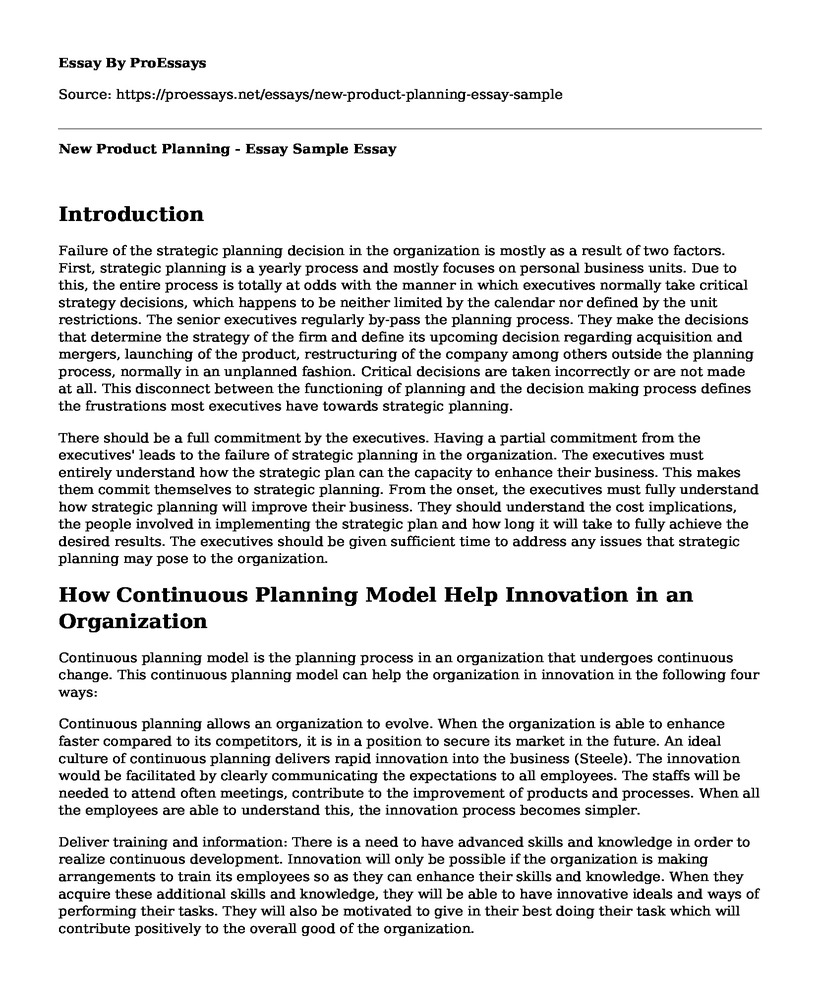Introduction
Failure of the strategic planning decision in the organization is mostly as a result of two factors. First, strategic planning is a yearly process and mostly focuses on personal business units. Due to this, the entire process is totally at odds with the manner in which executives normally take critical strategy decisions, which happens to be neither limited by the calendar nor defined by the unit restrictions. The senior executives regularly by-pass the planning process. They make the decisions that determine the strategy of the firm and define its upcoming decision regarding acquisition and mergers, launching of the product, restructuring of the company among others outside the planning process, normally in an unplanned fashion. Critical decisions are taken incorrectly or are not made at all. This disconnect between the functioning of planning and the decision making process defines the frustrations most executives have towards strategic planning.
There should be a full commitment by the executives. Having a partial commitment from the executives' leads to the failure of strategic planning in the organization. The executives must entirely understand how the strategic plan can the capacity to enhance their business. This makes them commit themselves to strategic planning. From the onset, the executives must fully understand how strategic planning will improve their business. They should understand the cost implications, the people involved in implementing the strategic plan and how long it will take to fully achieve the desired results. The executives should be given sufficient time to address any issues that strategic planning may pose to the organization.
How Continuous Planning Model Help Innovation in an Organization
Continuous planning model is the planning process in an organization that undergoes continuous change. This continuous planning model can help the organization in innovation in the following four ways:
Continuous planning allows an organization to evolve. When the organization is able to enhance faster compared to its competitors, it is in a position to secure its market in the future. An ideal culture of continuous planning delivers rapid innovation into the business (Steele). The innovation would be facilitated by clearly communicating the expectations to all employees. The staffs will be needed to attend often meetings, contribute to the improvement of products and processes. When all the employees are able to understand this, the innovation process becomes simpler.
Deliver training and information: There is a need to have advanced skills and knowledge in order to realize continuous development. Innovation will only be possible if the organization is making arrangements to train its employees so as they can enhance their skills and knowledge. When they acquire these additional skills and knowledge, they will be able to have innovative ideals and ways of performing their tasks. They will also be motivated to give in their best doing their task which will contribute positively to the overall good of the organization.
Showing consistency in the approach. Whichever the plan the organization opts to adopt in engendering development and growth, it is good to stick with it if indeed it is working. When employees know the reward system is going to last for long, they feel motivated and energized to perform their task effectively and efficiently. This also gives them room for coming up with innovative ways of performing certain tasks. They are aware that the organization will recognize their effort and determination in establishing innovative ways of performing their tasks.
Allowing room for mistakes and experiments. When the organization gives its employees room for errors and trials, they will be able to learn and eventually become experts in that field. This also helps the employees to become innovative.
Works Cited
Steele, Michael C. Mankins, and Richard. "Stop Making Plans; Start Making Decisions." Harvard Business Review (2019): 1-10.
Cite this page
New Product Planning - Essay Sample. (2022, Dec 08). Retrieved from https://proessays.net/essays/new-product-planning-essay-sample
If you are the original author of this essay and no longer wish to have it published on the ProEssays website, please click below to request its removal:
- Fred Hampton: I Am a Revolutionary
- Ethical and Sustainable Sourcing Essay
- Essay Example on Leadership in Heartland: Two Offices, Two Leaders, 14 Miles Apart
- Essay Sample on Optimizing Team Performance: Collaboration Through Communication and Gaming
- Essay Example on 4 Topics of Management: A Comprehensive Analysis
- Essay Example on Opening a Business: Location, Demographics, & More
- Leadership in Healthcare: The Need for Quality Care in Hospitals - Essay Sample







